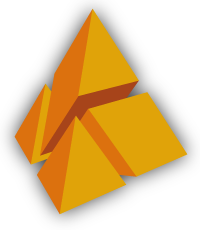Hi all,
again I am held back by a simple hurdle (… one from the large number of hurdles for complete greenhorns...) while beginning an attempt to evaluate my construction of a sculptural object (see attachment) that I constructed on the basis of the Tetartoid: How can I construct the perpendicular bisectors (which is hopefully the correct term) of all angles of the edges that meet in the single cornerpoints of a polyhedron with polymake ? (please excuse my stumbling explanation…)
Additionally I fail even by by the question of how to describe the Tetartoid (https://polytope.miraheze.org/wiki/Tetartoid) for polymake ?
(… with the aim in mind to use this description as well in the helpful algorithm you kindly and very helpful made available to me some months ago.)
Kind regards & thanks
Joachim Weinhold

